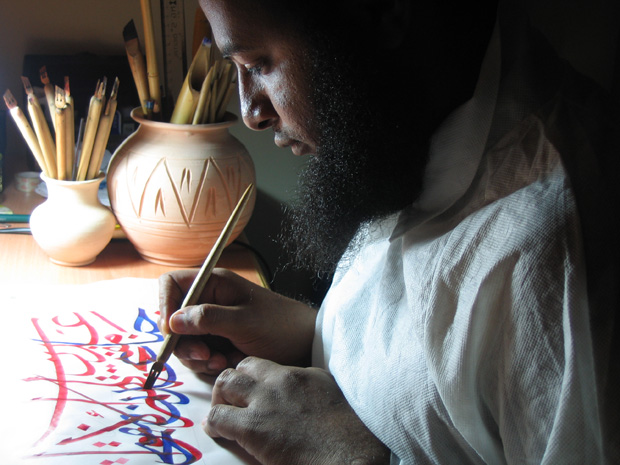
We've all gotten used to seeing Arabic calligraphy in regional hotels, galleries and exhibitions but rarely do we find artists that create contemporary pieces while still maintaining the elegance of the Arabic word. Renowned Omani calligrapher and artist Saleh Al Shukairi definitely knows how to maintain that delicate balance.
Sharpening his skills since 1993, Al Shukairi first started appreciating Arabic words for their visual beauty and then quickly became an apprentice to a number of Omani calligraphers he met in the Omani Arts Association. With a couple of years of practice and experience, Al Shukairi officially entered the art scene in 1997 with his first exhibition. He also visualized a way to take Arabic calligraphy further in that year and came up with a modern way to express the written letters. He succeeded by using the 28 Arabic letters strictly as visual elements and placed them in striking compositions. The idea was to prove that a beautiful artwork can be created from Arabic letters, even if people can't read what it actually says.
With upcoming books on the art of Arabic calligraphy and contemporary art in Oman, Al Shukairi is adamant on developing his knowledge and skills while hoping one day to become one of the top calligraphers in the region. Khaleejesque caught up with the experimental calligrapher to know more about his passion for Arabic letters and the compelling nature of his artworks.
What is so appealing to you about Arabic calligraphy?
Arabic calligraphy is our history and treasure. The Arabic letters are always dynamic in their shapes and lines and can be used in countless unique compositions. I sometimes surprise myself whenever I come up with a new idea or artwork, the letters can be used in so many ways and forms and I especially love using the letter "Waw" (واو) in my compositions.
How are you making Arabic calligraphy more contemporary?
By using the modern canvas and colors, I am making Arabic calligraphy more contemporary by using the same shapes and same methods but in a nontraditional way.
What would you like to reflect through your artwork?
I'd like to show how easily Arabic calligraphy can confuse the audience the first time they see my artworks. When focusing on the visual harmony of the letters instead of the content, it's difficult for people to make sense of the artwork. I don't know if this confusion is healthy or not but I like the fact that it is freely implemented and freely shown to people.
Which is your favorite artwork?
“Esheq” series which I've made especially for “Love & Peace” in the world. I've shown everyone that love and peace are all you need in this world.
What is the main difference between Arabic/Turkish/Iranian calligraphy art? Which do you prefer?
I like all of the Arabic calligraphy styles. All of them have got their own history, stories, pioneers and founders. I respect all of that but I like using the “Thuluth" and "Farsi" style in most of my artworks.
– Khaleejesque Staff
Images courtesy of Saleh Al-Shukairi










2 comments
Dear Mr. Al Shukairi,
I have seen You in the NHG Nürnberg, showing people there the art of arabian calligraphy.
I didn´t want to disturb, because my concern has not primarily to do with calligraphy.
For almost twenty years, I am interested in the botanical aspect of Boswellia and Commiphora.
What I am meanwhile knowing about this subject asks to be published.
From the myrrh /frankincense producing species in Somalia, I have the Somali names, from Yemen I
have names, that I don´t know from which dialect they origin and from and from Oman, I have the
Jibbali and Zufari names. Those names are all transcribed into latin alphabet.
May I ask You to convert the names of the frankincense / myrrh producing species to arabic, so every
arabian person can read it. I want to show this together with the scientific name.
One more thing – I have heard, that nobody collected You from the airport in Munich.
I feel bad about this fact and I want to apologize for NHG people behavior.
Respectfully
Peter Glas
Dear Mr. Al Shukairi,
I have seen You in the NHG Nürnberg, showing people there the art of arabian calligraphy.
I didn´t want to disturb, because my concern has not primarily to do with calligraphy.
For almost twenty years, I am interested in the botanical aspect of Boswellia and Commiphora.
What I am meanwhile knowing about this subject asks to be published.
From the myrrh /frankincense producing species in Somalia, I have the Somali names, from Yemen I
have names, that I don´t know from which dialect they origin and from and from Oman, I have the
Jibbali and Zufari names. Those names are all transcribed into latin alphabet.
May I ask You to convert the names of the frankincense / myrrh producing species to arabic, so every
arabian person can read it. I want to show this together with the scientific name.
One more thing – I have heard, that nobody collected You from the airport in Munich.
I feel bad about this fact and I want to apologize for NHG people behavior.
Respectfully
Peter Glas